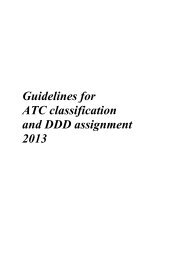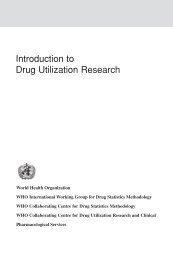Download - WHOCC
Download - WHOCC
Download - WHOCC
Create successful ePaper yourself
Turn your PDF publications into a flip-book with our unique Google optimized e-Paper software.
QP53AA<br />
Sulfur-containing products<br />
Various sulphur compounds, e.g. dixanthogen, mesulfen and disulfiram, are<br />
classified in this group.<br />
Combinations with for example benzyl benzoate are classified in this group.<br />
Combinations with chlorine compounds, see QP53AB.<br />
QP53AB<br />
Chlorine-containing products<br />
Lofenotane and lindane, for example, are classified in this group as are<br />
combinations with sulphur compounds.<br />
QP53AC<br />
Pyrethrins and pyrethroids<br />
Various pyrethrum products, including synthetic pyrethroids and combinations with<br />
e.g. piperonyl butoxide are classified in this group.<br />
The combination of permethrin and imidacloprid is classified here.<br />
The combination of permethrin and pyripoxifen is classified here.<br />
QP53AD<br />
Amidines<br />
The combination of amitraz and metaflumizione is classified here.<br />
QP53AE<br />
QP53AF<br />
QP53AX<br />
Carbamates<br />
Organophosphorous compounds<br />
Other ectoparasiticides for topical use<br />
The combination of imidaclopride and permethrin is classified in QP53AC.<br />
The combination of pyriproxifen and permethrin is classified in QP53AC.<br />
The combination of amitraz and metaflumizone is classified in QP53AD.<br />
Combinations with eucalyptus oil, camphora and levomentol is allowed at the plain<br />
level for thymol (QP53AX22).<br />
QP53B<br />
ECTOPARASITICIDES FOR SYSTEMIC USE<br />
The classification is made according to the main therapeutic use.<br />
Products for systemic use against ectoparasites are classified in this group.<br />
Products also used as anthelmintics are classified in QP52.<br />
157





